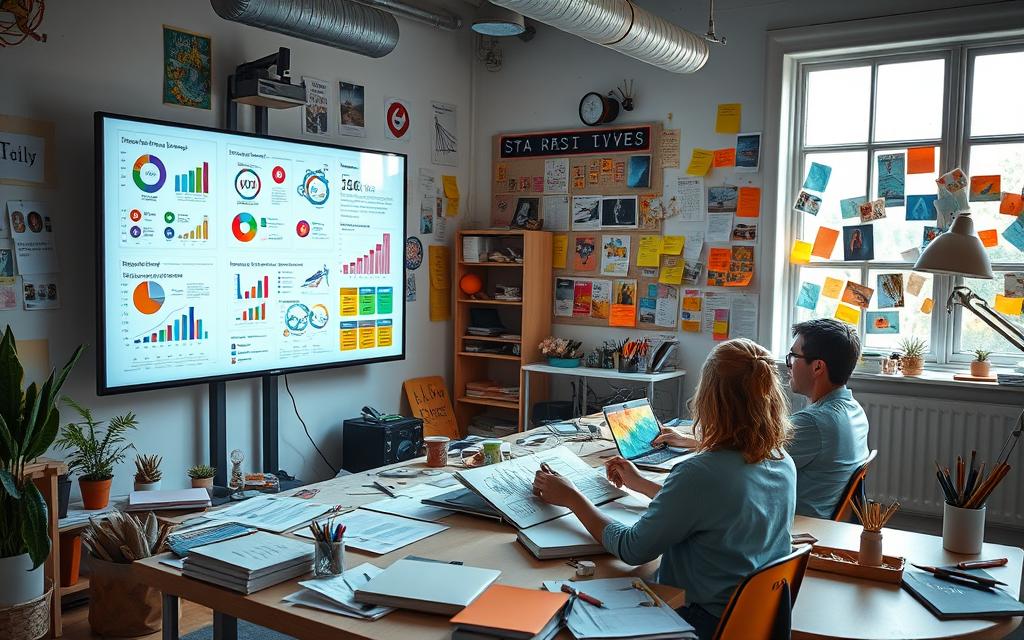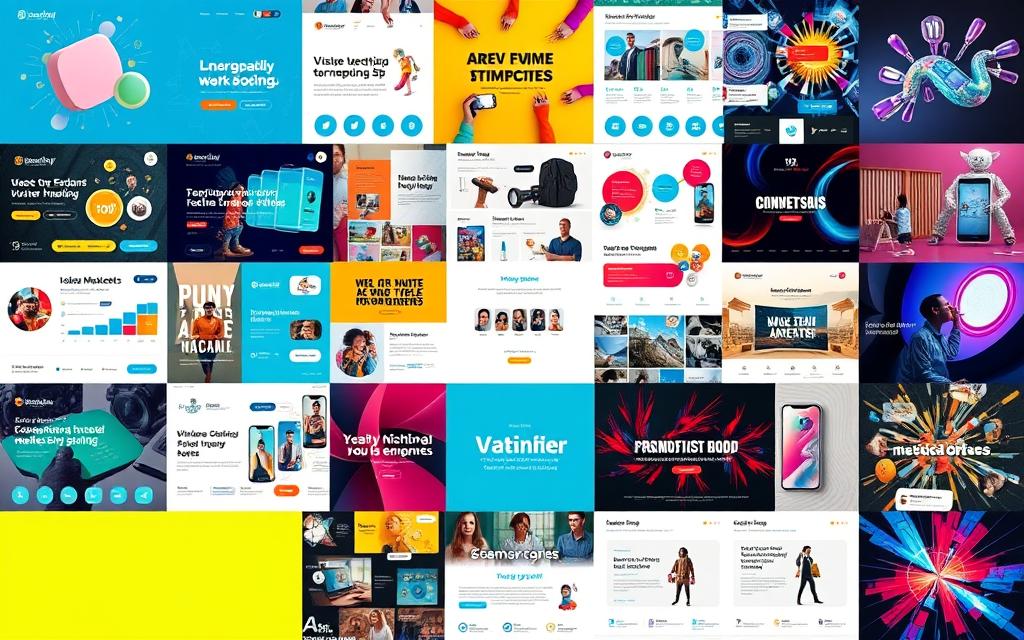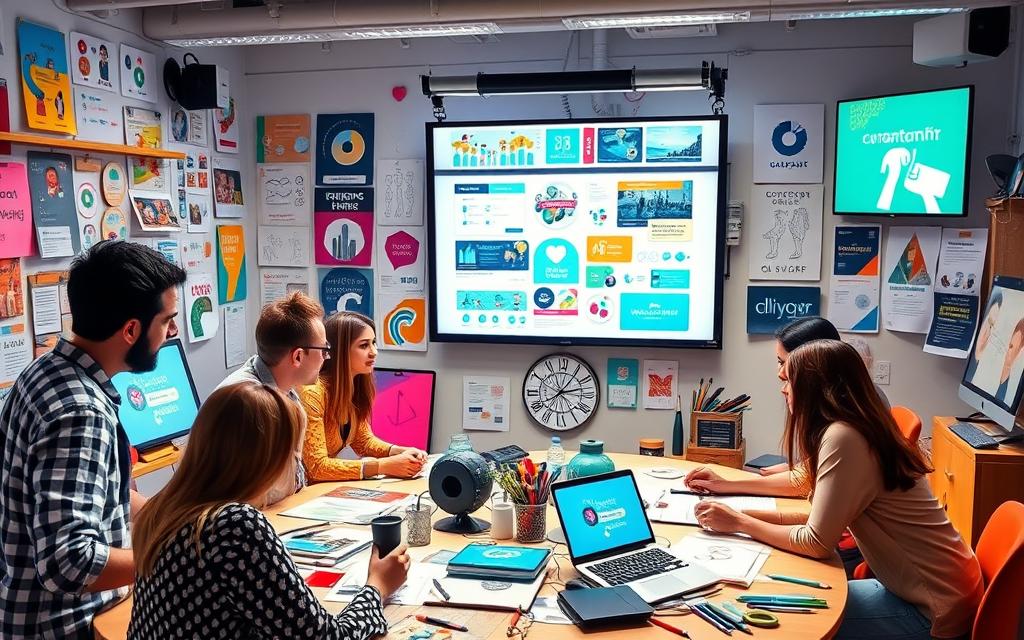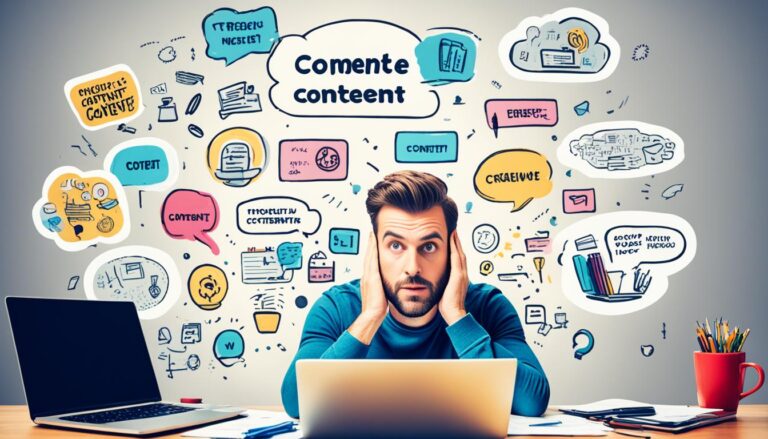Visual Content Marketing: Boost Your Brand Impact
Did you know that visual content can boost viewer engagement by 80%? In today’s fast-paced digital world, using visual content marketing is key. It helps brands stand out by adding images, videos, and infographics to their strategies.
This article will cover the basics of visual content marketing. We’ll look at effective strategies, new trends, and how to create engaging visuals. By mastering these, brands can grab their audience’s attention and share their message well. We’ll also explore how to keep a consistent brand look and share success stories.
Key Takeaways
- Visual content can significantly boost engagement and improve brand recognition.
- Consistency in color and design elements enhances brand identity.
- The audience processes visual information 60,000 times faster than text, highlighting the importance of visuals in marketing.
- Video content has shown considerable ROI, making it a crucial component of marketing strategies.
- Understanding and implementing effective visual marketing strategies can lead to measurable success.
- Staying updated on visual content trends is necessary for capturing audience attention.
What is Visual Content Marketing?
Visual content marketing uses images, videos, and infographics to connect with people. It’s key in today’s world where visuals are more important than text. Brands use it to make their visual branding stand out, knowing that visuals are processed faster than text.
Adding visuals to marketing makes a brand’s message stick in people’s minds. The visual content marketing definition shows how important it is to make content that people can relate to. For example, images get 94% more views than just text, showing how crucial visuals are for grabbing attention.
Companies like Savage X Fenty have seen huge success with their visual strategy. They reached a $1 billion valuation just two years after starting. This shows how powerful visuals are in building a brand and keeping customers loyal. Also, using content from customers, like Abercrombie & Fitch did, can really increase engagement and reach.
To learn more about effective strategies for content distribution, understanding visual content marketing is essential. By focusing on visuals, brands can boost engagement and achieve better results in a crowded digital space.
Why is Visual Content Marketing Important?
Visual content marketing has big benefits, affecting how people engage and see your brand. Studies show that articles with images get 94% more views than those without. This highlights how important visuals are in grabbing and keeping people’s attention.
Using visuals to tell stories boosts brand engagement by 20%. Companies that do this well connect with customers on a deeper level. This emotional bond is crucial in today’s competitive market.
Visual content also helps with SEO. Pages with images tend to rank higher in search results. This means more people see your site, leading to more potential customers. Videos on landing pages can increase conversions by 80%, showing how engaging media keeps users interested.
On social media, visuals are shared 40 times more than other types of content. Tweets with images get 150% more retweets, boosting engagement by up to 650%. These numbers show how vital visuals are in today’s marketing.
In short, visual marketing is key. Businesses that use it well have a 63% better chance of making a profit. As more people want to see visuals, companies that focus on this strategy are likely to succeed.
Understanding Visual Marketing Strategies
Effective visual marketing strategies are key for brands to connect with their audience. Using digital tactics with visuals grabs attention fast. Videos can share the same message as 1.8 million words in just one minute, making communication better.
High-quality visuals like videos and infographics improve website experience. They lower bounce rates and help websites rank higher on search engines. With 79% of internet traffic coming from videos, it’s clear why they’re important.
Brands should make engaging infographics to share complex ideas. Infographics boost information retention by over 78%. Adding humor with memes or gifs also connects with users, making the brand more relatable.
Using these visual techniques can increase conversions. Landing pages with videos can see an 800% boost in conversion rates. Brands that focus on visual content can reach more people and boost brand awareness.

Visual Content Trends to Watch
The world of visual content marketing is changing fast. It’s key to keep up with the latest visual marketing techniques. These trends are making a big impact on how we connect with consumers.
Retro designs are big right now, bringing back old-school charm. This trend has been popular for about five years and shows no signs of slowing down.
Short-form video content is a big hit, offering great returns and keeping people engaged. Studies show that 75% of adults in the U.S. watch these videos on their phones. People love seeing real, unfiltered stories in short videos.
Brands are focusing on making content that feels personal. Text posts are becoming more popular in crowded feeds. They help start conversations and build connections with followers.
Video is a big deal, with 50% of marketers using it in their plans. Images are close behind, at 47%. Long-form videos, like webinars and live events, have seen a huge jump, growing over 11,000%.
Most people want to see more videos from brands, with 91% of consumers saying so. This shows video’s key role in visual marketing.
Over 60% of marketers updated their visual content strategies in 2023. They’re focusing on mobile-first designs and video content. Keeping up with new trends helps brands stay relevant and grab consumer attention in a fast-changing digital world.
Creating Engaging Visual Content
Creating engaging visual content is key to grabbing audience attention and boosting interaction. High-quality visuals that match your brand’s identity are crucial. They lay the groundwork for effective multimedia content creation. By following core design principles, you can make your visuals appealing. This means colors, fonts, and layout work well together.
Using engaging visual content tips means having a clear visual order. This order helps viewers follow your content easily. Studies by Quartz show that people remember 80% of what they see. This shows how important well-structured visuals are.
Different formats like infographics, videos, and animations appeal to different people. Since visuals are shared 40 times more than text, it’s important to use multimedia content that speaks to your audience. Knowing what formats work best helps brands reach their goals better.
Interactive content like quizzes and polls can really get people involved. These elements can increase interaction rates by 80%. With 91% of people preferring visual content over text, investing in quality visuals is smart.
It’s important to check how well your visual content is doing. Look at engagement and click-through rates to see what works. This helps you make your visual marketing even better. By sticking to these practices, brands can improve their visual storytelling and engage their audience more.
Visual Storytelling Techniques for Brands
Visual storytelling is key in today’s marketing. It helps brands connect with people in meaningful ways. Studies show that people remember about 95% of a message when it’s shown in pictures, compared to just 10% for text.
Using videos and infographics makes stories more engaging. For example, adding images to content can increase views by 94%. Also, 53% of people want more videos from brands they like, making videos a great choice for visual storytelling.
Campaigns like Nike’s “Dream Crazy” and Coca-Cola’s “Share a Coke” show the power of personal stories. They share brand values and create emotional bonds with customers. Having a consistent look helps your brand stand out and make a lasting impression.
Being real is important in visual storytelling. Telling stories of real people connects with your audience. Using visual elements guides viewers, making them more engaged and emotional. This approach makes your brand’s message stronger and encourages people to act.
Visual Content Marketing: Tips for Improved Engagement
Creating engaging visual content is key for brands wanting to connect better with their audience. One important tip is to keep the quality consistent. A study found that 43% of marketers struggle to maintain high-quality visuals.
Using different types of visuals, like infographics, videos, and memes, can boost interaction. Articles with visuals get shared twice as much as those without. Images help share messages fast, making it easier for people to understand.
Adding calls-to-action in visuals can also improve audience interaction. This can prompt users to sign up for newsletters or share posts. For example, LinkedIn posts with images get 98% more comments. Tweets with visuals get 150% more retweets, showing the power of good graphics.
Tracking how well your content does is vital. This lets brands improve their strategies and see what works best. Using AI tools can help target content to specific groups. Brands that use diverse visuals often get a positive response, strengthening their identity and engagement.
Maximizing Visual Impact on Social Media
Social media marketing relies on eye-catching visuals to stand out online. Sites like Instagram, Facebook, and LinkedIn do well with high-quality images. These images should fit each platform’s size to grab more attention.
Videos are great for sharing lots of info quickly. They can show behind-the-scenes or how-to tutorials. Videos get 12 times more shares than text and images, making them a powerful tool for engagement.
GIFs and memes can also connect with people in a fun way. They make content relatable and engaging. User-generated content, like real people using your product, builds trust and gets 6.9 times higher engagement than content made by brands.
Infographics are great for showing complex data in a simple way. Posts with visuals get 94% more views. This shows how important it is to add compelling images to your social media plans.
Figuring out which visuals work best helps improve your content. Tailoring your visuals for each platform shows you care about quality. Using a series of images tells a story and builds a connection with your audience.
Knowing your audience and their likes helps you create content they’ll enjoy. This, along with consistent branding, can increase sales by up to 23%. Use visuals to boost engagement on social media and see how it changes your brand’s online presence. For more tips on using visuals, check out here.
Case Studies: Successful Visual Campaign Examples
Many brands have seen the power of visual campaigns. Bloomreach’s campaign got 13 million impressions, beating their goals. It also made 10% of their target accounts aware of the brand, showing how visuals can engage people.
VideoAmp’s rebranding led to a huge 850% increase in leads, way more than they hoped for. They got $1.4 billion in funding and won awards. This proves that good design can lead to real business wins.
Dropbox’s employer branding campaign boosted their market perception by 7%. It raised their Glassdoor rating to 4.5 from 3.7. This shows how visuals can change how people see a brand and make them loyal.
Teach for America’s campaign did 124% better than expected, showing the strength of visual strategies. Course Hero made 600 infographic study guides, getting lots of social media attention. This shows how visuals can engage people.

Campaigns like Most Instagrammed Locations and Perceptions of Perfection show the impact of visuals. The first got nearly 40,000 shares, and the second over 900,000 shares and 700,000 page views. Both got a lot of media coverage, proving visuals can tell compelling stories.
Optimizing Visual Content for SEO
To boost visual content in SEO, brands need to use visual SEO strategies. They should name images and videos clearly and add alt tags. Also, include the right keywords in descriptions. This makes content easier to find and more accessible to everyone.
High-quality images and videos are key for SEO-friendly visual content. Adding metadata like titles and tags helps search engines understand and rank them better. Also, image sitemaps help show what visual content is on a site, making it easier to find.
With more people using mobiles, making content mobile-friendly is crucial. Using smaller images and videos speeds up loading times. This improves user experience and SEO. Plus, sharing engaging visuals on social media increases visibility and interaction.
Tracking how well visual content works is important for brands. Look at page views and conversion rates to see how people interact with SEO-friendly visual content. As the online world changes, updating visual strategies helps keep audiences engaged and brands strong.
Conclusion
Visual content marketing is key in today’s digital world. It helps brands connect with their audience better. Using images, videos, and infographics makes complex info easy to understand.
These visuals create lasting memories for your audience. This approach boosts engagement and keeps people interested in your brand.
Quality visuals and storytelling are crucial. Hubspot shows that images in social media posts get more retweets and clicks. This shows how visuals can make your brand more successful online.
As visual content marketing grows, brands must stay up-to-date. They need to connect with people on an emotional level. This way, they can increase brand awareness and get better results.
FAQ
What is visual content marketing?
Visual content marketing uses images, infographics, and videos to connect with people. It’s more than just text. It helps brands share their identity, values, and messages in a way that sticks with people.
Why should my brand invest in visual content marketing?
Visual content marketing is key because visuals grab attention much more than text. They make stories clearer and keep people interested. This leads to better brand memory and loyalty.
What are some effective visual marketing strategies?
Good strategies include knowing what your audience likes and using high-quality visuals. Use infographics for complex info and tailor content for different places. Adding interactive and personalized content also boosts engagement.
How do I create engaging visual content?
To make engaging content, use visuals that match your brand and follow a clear order. Mix up your content types like photos, infographics, and videos. This appeals to different tastes.
What are the latest trends in visual content marketing?
Trends include short videos, interactive content like polls, and AR and 360-degree videos. Brands are also focusing on making content personal and immersive. This is key for today’s consumers.
How important is visual storytelling in content marketing?
Visual storytelling is crucial. It uses images and videos to tell stories that connect with people. Being real and relatable is key. Brands should make content that touches viewers’ hearts and shows their values.
How can I optimize my visual content for SEO?
For better SEO, use clear file names and alt tags for images. Make sure they load fast and work on mobile. Update your visuals often and include the right keywords. This helps people find your content online.
What are some successful visual content campaign examples?
Starbucks’ “White Cup Contest” got people involved and creating content. GoPro’s “Be a Hero” campaign showed off user-made videos. Apple’s “Shot on iPhone” campaign used user photos to show off the phone’s features and build a community.







